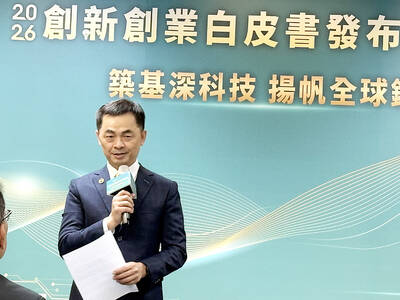Qualcomm Inc, the world’s largest mobile phone chipmaker, yesterday said it is looking to increase its investment in Taiwan and deepen its collaboration with local partners in the Internet-of-Things (IoT) and 5G fields.
The San Diego, California-based company said that President Tsai Ing-wen’s (蔡英文) administration has placed IoT and 5G on its policy agenda to help drive economic growth, which is the right approach and aligns well with Qualcomm’s investment and business model.
“Qualcomm has a long history of investing and partnering here in Taiwan,” Qualcomm president Derek Aberle told a news briefing in Taipei. “We have a long future ahead of us in increasing the level of collaboration and investment here.”
In the 5G area, Qualcomm has been collaborating closely with the Ministry of Economic Affairs and the Industrial Technology Research Institute to develop technologies to help Taiwanese companies focusing on 5G applications grow, Aberle said.
Small cells and virtual-reality (VR) devices could be two of those applications, Aberle said.
In the IoT area, Qualcomm plans to expand the role of a new innovation lab set up in Taiwan in November last year, he said.
The lab will also be a start-up incubator as the functions of the lab increase, he said.
The lab was set up to accelerate time to market for local companies in the smartphone and IoT sectors by helping Taiwanese companies, especially smaller-scale firms, to obtain certifications for wireless connectivity.
Qualcomm is also to make direct investments in VR hardware companies, VR content developers and gaming companies to help build an ecosystem for VR and 5G, Aberle said.
Talking about Qualcomm’s newly announced joint venture with China’s Data Telecom Industry Group (大唐電信) in Guizhou Province, Aberle said Qualcomm aims to address the large number of smartphone and tablet original equipment manufacturers in China by partnering with local firms.
The joint venture will supply chips for entry-level mobile devices for the emerging markets, he said.
However, in Taiwan, Qualcomm will focus on supplying chips for high-end and higher-value devices from companies including HTC Corp (宏達電) and Asustek Computer Inc (華碩), he said.
Aberle declined to comment on MediaTek Inc’s (聯發科) goal to recoup lost market share in China over the next year and a half.
“The market is extremely competitive. We have competition from the supplier you mentioned,” Aberle said. “We feel very good about our position.”
Asked whether he thinks Moore’s law — which predicts that the number of transistors per square inch on integrated circuits double — is coming to an end, Aberle said: “It is true that it is getting harder and harder to get into smaller geometries, but it [Moore’s law] is definitely durable.”
Qualcomm will continue to push process technology advances to drive the need for next-generation technologies with partners such as Taiwan Semiconductor Manufacturing Co (台積電), he said.

CHIP RACE: Three years of overbroad export controls drove foreign competitors to pursue their own AI chips, and ‘cost US taxpayers billions of dollars,’ Nvidia said China has figured out the US strategy for allowing it to buy Nvidia Corp’s H200s and is rejecting the artificial intelligence (AI) chip in favor of domestically developed semiconductors, White House AI adviser David Sacks said, citing news reports. US President Donald Trump on Monday said that he would allow shipments of Nvidia’s H200 chips to China, part of an administration effort backed by Sacks to challenge Chinese tech champions such as Huawei Technologies Co (華為) by bringing US competition to their home market. On Friday, Sacks signaled that he was uncertain about whether that approach would work. “They’re rejecting our chips,” Sacks

NATIONAL SECURITY: Intel’s testing of ACM tools despite US government control ‘highlights egregious gaps in US technology protection policies,’ a former official said Chipmaker Intel Corp has tested chipmaking tools this year from a toolmaker with deep roots in China and two overseas units that were targeted by US sanctions, according to two sources with direct knowledge of the matter. Intel, which fended off calls for its CEO’s resignation from US President Donald Trump in August over his alleged ties to China, got the tools from ACM Research Inc, a Fremont, California-based producer of chipmaking equipment. Two of ACM’s units, based in Shanghai and South Korea, were among a number of firms barred last year from receiving US technology over claims they have

Taiwan’s exports soared 56 percent year-on-year to an all-time high of US$64.05 billion last month, propelled by surging global demand for artificial intelligence (AI), high-performance computing and cloud service infrastructure, the Ministry of Finance said yesterday. Department of Statistics Director-General Beatrice Tsai (蔡美娜) called the figure an unexpected upside surprise, citing a wave of technology orders from overseas customers alongside the usual year-end shopping season for technology products. Growth is likely to remain strong this month, she said, projecting a 40 percent to 45 percent expansion on an annual basis. The outperformance could prompt the Directorate-General of Budget, Accounting and

BARRIERS: Gudeng’s chairman said it was unlikely that the US could replicate Taiwan’s science parks in Arizona, given its strict immigration policies and cultural differences Gudeng Precision Industrial Co (家登), which supplies wafer pods to the world’s major semiconductor firms, yesterday said it is in no rush to set up production in the US due to high costs. The company supplies its customers through a warehouse in Arizona jointly operated by TSS Holdings Ltd (德鑫控股), a joint holding of Gudeng and 17 Taiwanese firms in the semiconductor supply chain, including specialty plastic compounds producer Nytex Composites Co (耐特) and automated material handling system supplier Symtek Automation Asia Co (迅得). While the company has long been exploring the feasibility of setting up production in the US to address